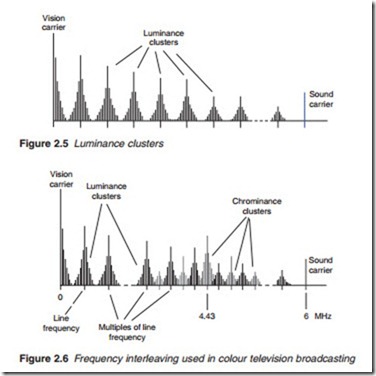Principles of colour transmission
To meet the requirements of compatibility, the luminance signal Y is trans- mitted in the same way as in a monochrome system within which the chrominance is be contained. The next step is to produce the pure chromi- nance component from the RGB signal. To do this, the luminance had to be removed from the three primary colours, resulting in what is known as colour difference signals: R – Y, G – Y and B – Y.
Since the luminance signal Y = R + G + B, and luminance Y is to be transmitted in full, only two colour difference signals need to be transmit- ted. Of the three colour difference signals, Y – G normally has the smallest value. For this reason, difference signals (R – Y) and (B – Y) are selected. The missing (G – Y) is recovered at the receiving end from the three trans- mitted components as follows:
The remaining issue that has to be resolved is the manner in which this additional information, R – Y and B – Y, is added to the monochrome signal without causing it any interference. To do this, a separate colour subcarrier [4.43 MHz for Phase Alternate Line (PAL) and 3.58 MHz for National Television System Committee (NTSC)] is introduced which is then modulated by the two-chrominance components using quadrature amplitude modulation (QAM).
Frequency interleaving
Since the modulated colour subcarrier falls within the monochrome frequency spectrum, its sidebands naturally overlap with those produced by the original vision carrier. This overlap will result in pronounced pattern- ing on a monochrome set receiving colour transmission. This is avoided by the choice of the subcarrier frequency resulting in what is known as frequency interleaving.
When the frequency spectrum of a TV signal is examined in detail, it is found that the distribution of frequencies is not uniform. Energy tends to gather in bunches centred on the harmonics, i.e. multiples of line frequency, known as monochrome clusters (Figure 2.5). This is not that surprising since the video information is sent out line by line. Furthermore, the ampli- tude of these side frequencies gets progressively smaller as we move away from the vision carrier. Similarly, colour information would also bunch into chrominance clusters. By choosing the subcarrier to fall between two monochrome clusters, the chrominance clusters may be arranged to fall
neatly in the spaces between the clusters produced by the monochrome sig- nal (Figure 2.6). The choice of the subcarrier frequency thus becomes very critical. Since the clusters are centred on multiples of line frequency, the colour subcarrier has to be an odd multiple of half the line frequency, known as half-line offset, for its clusters to interleave with the monochrome clusters. For NTSC, a multiple n = 455 is used giving a subcarrier frequency fsc = n X fh/2 where fh is the line or horizontal frequency
A high-value multiplier is used to position the colour clusters at the higher end of the video bandwidth where the monochrome clusters are small in amplitude. As for the reason for choosing an odd rather than an even mul- tiplier, it is to remove the pattern of alternate black and white dots appear- ing along each line scan. The number of these dots corresponds to the
Since the multiple n is an odd number (455 for NTSC), then the number of subcarrier cycles per line will always be an odd half cycle at the end of the line. In other words, there will be subcarrier reversal line by line as illustrated in Figure 2.7 and the eye will see the average brightness of the line pairs can- celling out the dot pattern. Chrominance C will therefore change phase, line by line with Y + C on one line and Y – C on the following line and so on.
Furthermore, the choice half-line offset means that not only the colour clock cycles per line ends with a half cycle, but the number per frame also ends with a half cycle which for NTSC is
This ensures that the same point on the screen alternates in brightness from frame to frame about a value determined by the luminance signal.
While this will reduce the interference pattern to practically invisible level in the NTSC system, the nature of PAL is such that certain hues may experience an annoying vertical dot pattern. This is removed by using quarter-line offset making the subcarrier a multiple of one-quarter the line frequency which still reverses the chrominance on successive lines. However, a further modification is required, namely a phase reversal on successive fields if the dot pattern is to be removed completely. To do this, the colour subcarrier is further modified by adding the half-field frequency (25 Hz) to create a phase reversal on a successive field. The dot pattern will thus be reversed on suc- cessive fields to be cancelled out by the averaging process of the eye. PAL, in the UK, uses a multiple n = 1135 resulting in a subcarrier frequency of
As far as line and frame reversal of the subcarrier, PAL is exactly the same as NTSC.




